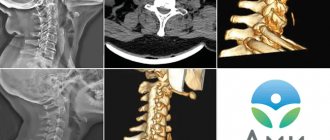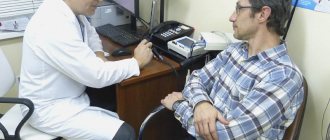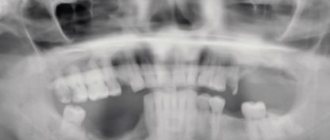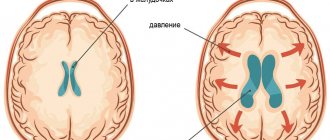Multiple sclerosis
– a disease of the nervous system that can occur both in young and middle age (15–40 years). Multiple sclerosis tends to affect various parts of the nervous system, which leads to the appearance of a variety of neurological symptoms. Most often, women aged 20 to 40 years are affected by the disease. Multiple sclerosis affects the spinal cord and brain and leads to impaired coordination, vision and sensitivity in the patient.
It is important to note that multiple sclerosis is an autoimmune disease.
, in which the immune system, instead of fighting foreign cells, begins to fight its own healthy cells.
During the course of the disease, the patient develops areas of sclerotic tissue or scars in the area of the brain and spinal cord, as a result of which the energy impulses passing through these areas are suppressed or distorted, which leads to disruption of the functioning of the entire body.
Types of Multiple Sclerosis
Multiple sclerosis comes in different types; depending on this, the treatment method is determined and the complexity of the disease is predicted. Types of multiple sclerosis include:
Primary progressive:
sclerosis, in which there is a constant deterioration in the patient’s condition. The attacks are mild or not noticeable at all. At this stage of sclerosis, problems with walking, vision, speech, bowel movements and urination occur.
Relapsing-remitting:
generally begins to manifest itself at the age of 15-20 and is characterized by periodic attacks. The symptoms of the disease are constantly changing and can manifest themselves in the form of pain in the eyes, dizziness, depression, decreased thinking, and deterioration of coordination.
Secondary progressive:
This type of sclerosis develops on the basis of relapsing-remitting sclerosis, which lasted a long period of time (several years). This type is characterized by a stable onset, without any special relapses or remissions. Symptoms include a significant deterioration in coordination of movements, increased depression, problems with thinking, high fatigue, and disturbances in the functioning of the intestines and bladder.
Progressive-relapsing:
a mildly widespread type of sclerosis with periodic attacks and persistence of symptoms between relapses. Symptoms are similar to secondary progressive sclerosis.
Sign up for treatment for multiple sclerosis
Make an appointment
Amyotrophic lateral sclerosis (and ALS syndrome)
Amyotrophic lateral sclerosis (ALS) (also known as motor neuron disease, Motor neuron disease, Charcot's disease, in English-speaking countries - Lou Gehrig's disease) is a progressive, incurable degenerative disease of the central nervous system, which affects both the upper (motor cortex) brain) and lower (anterior horns of the spinal cord and nuclei of the cranial nerves) motor neurons, which leads to paralysis and subsequent muscle atrophy.
General information.
The disease has not been known for long. First described by Jean-Martin Charcot in 1869. According to statistics, it is detected in 2-5 people per 100,000 population per year, which suggests that this pathology is relatively rare. In total, there are about 70 thousand patients with amyotrophic lateral sclerosis in the world. The disease usually manifests itself in people over 50 years of age.
More recently, it has been suggested that cases of amyotrophic lateral sclerosis are more often recorded in highly intelligent people, professionals in their field, as well as in athletes who have been in good health throughout their lives.
In 90% of cases, ALS is sporadic, and in 10% it is familial or hereditary in nature, with both autosomal dominant (predominantly) and autosomal recessive types of inheritance. The clinical and pathological characteristics of familial and sporadic ALS are almost identical.
The exact etiology of ALS is unknown.
Pathogenesis.
The essence of the disease lies in the degeneration of motor neurons, i.e. under the influence of a number of reasons, the process of destruction of nerve cells responsible for muscle contractions is started. This process affects neurons of the cerebral cortex, cerebral nuclei and neurons of the anterior horns of the spinal cord. Motor neurons die, and no one else performs their functions. Nerve impulses no longer reach muscle cells. And the muscles weaken, paresis and paralysis develop, and muscle tissue atrophy develops.
If amyotrophic lateral sclerosis is based on a mutation in the superoxide dismutase-1 gene, then the process looks something like this. Mutant superoxide dismutase-1 accumulates in the mitochondria of motor neurons (in the energy stations of the cell). This “interferes” with the normal intracellular transport of protein formations. The proteins connect with each other, as if sticking together, and this starts the process of cell degeneration.
If the cause is excess glutamate, then the mechanism that triggers the destruction of motor neurons is as follows: glutamate opens channels in the neuron membrane for calcium. Calcium rushes into the cells. Excess calcium, in turn, activates intracellular enzymes. Enzymes seem to “digest” the structures of nerve cells, and a large number of free radicals are formed. And these free radicals damage neurons, gradually leading to their complete destruction.
It is assumed that the role of other factors in the development of ALS is also the triggering of free radical oxidation.
Classification of ALS, forms:
- lumbosacral;
- cervicothoracic;
- bulbar: with damage to a peripheral motor neuron in the brain stem;
- high: with damage to the central motor neuron.
Common symptoms characteristic of any form of amyotrophic lateral sclerosis are:
- purely motor disorders;
- absence of sensory disorders;
- absence of disorders of the urination and defecation organs;
- steady progression of the disease with the capture of new muscle masses up to complete immobility;
- the presence of periodic painful cramps in the affected parts of the body, they are called cramps.
Clinic
Initial manifestations of the disease: •weakness in the distal arms, awkwardness when performing fine movements with the fingers, weight loss in the hands and fasciculations (muscle twitching) •less commonly, the disease debuts with weakness in the proximal arms and shoulder girdle, atrophy in the leg muscles in combination with lower spastic paraparesis •it is also possible that the disease begins with bulbar disorders - dysarthria and dysphagia (25% of cases) •cramps (painful contractions, muscle spasms), often generalized, are found in almost all patients with ALS, and are often the first sign of the disease. ALS in most cases is characterized by asymmetry symptoms.
Lumbosacral shape:
With this form of the disease, two options are possible:
- the disease begins only with damage to the peripheral motor neuron located in the anterior horns of the lumbosacral spinal cord. In this case, the patient develops muscle weakness in one leg, then it appears in the other, tendon reflexes (knee, Achilles) decrease, muscle tone in the legs decreases, atrophy gradually forms (this looks like weight loss in the legs, as if “drying out”) . At the same time, fasciculations are observed in the legs - involuntary muscle twitching with a small amplitude (“waves” of muscles, muscles “moving”). Then the arm muscles are involved in the process, their reflexes also decrease, and atrophy forms. The process goes higher - the bulbar group of motor neurons is involved. This leads to the appearance of symptoms such as difficulty swallowing, blurred and unclear speech, a nasal tone of voice, and thinning of the tongue. Choking occurs when eating, the lower jaw begins to sag, and problems with chewing appear. There are also fasciculations on the tongue;
- at the onset of the disease, signs of simultaneous damage to the central and peripheral motor neurons that provide movement in the legs are revealed. In this case, weakness in the legs is combined with increased reflexes, increased muscle tone, and muscle atrophy. Pathological foot symptoms of Babinsky, Gordon, Schaeffer, Zhukovsky, etc. appear. Then similar changes occur in the hands. Then the motor neurons of the brain are also involved. Disturbances in speech, swallowing, chewing, and twitching in the tongue appear. Violent laughter and crying join in.
Cervicothoracic form:
Can also debut in two ways:
- damage to only the peripheral motor neuron - paresis, atrophy and fasciculations appear, decreased tone in one hand. After a couple of months, the same symptoms appear in the other hand. The hands take on the appearance of a “monkey’s paw”. At the same time, increased reflexes and pathological foot signs without atrophy are detected in the lower extremities. Gradually, muscle strength decreases in the legs, and the bulbar part of the brain is involved in the process. And then blurred speech, problems with swallowing, paresis and fasciculations of the tongue appear. Weakness in the neck muscles is manifested by drooping of the head;
- simultaneous damage to central and peripheral motor neurons. In the arms there are simultaneously atrophies and increased reflexes with pathological signs of the hand, in the legs there are increased reflexes, decreased strength, and pathological foot symptoms in the absence of atrophies. Later, the bulbar region is affected.
Bulbar form:
- In this form of the disease, the first symptoms of damage to the peripheral motor neuron in the brain stem are articulation disorders, choking when eating, nasal voice, atrophy and fasciculations of the tongue. Movement of the tongue is difficult. If the central motor neuron is also affected, then these symptoms are accompanied by an increase in the pharyngeal and mandibular reflexes, violent laughter and crying. The gag reflex increases.
As the disease progresses, paresis forms in the hands with atrophic changes, increased reflexes, increased tone and pathological foot signs. Similar changes occur in the legs, but somewhat later.
High form:
This is a type of amyotrophic lateral sclerosis, when the disease occurs with primary damage to the central motor neuron. At the same time, paresis is formed in all muscles of the trunk and limbs with increased muscle tone and pathological symptoms.
Bulbar and high forms of ALS are prognostically unfavorable. Patients with this onset of the disease have a shorter life expectancy compared to the cervicothoracic and lumbosacral forms. Whatever the first manifestations of the disease, it progresses steadily.
Paresis in various limbs leads to impaired ability to move independently and take care of oneself. Involvement of the respiratory muscles in the process initially leads to the appearance of shortness of breath during physical activity, then shortness of breath becomes disturbing at rest, and episodes of acute lack of air appear. In the terminal stages, independent breathing is simply impossible; patients require constant artificial ventilation.
According to various sources, the life expectancy of a patient with ALS ranges from 2 to 12 years, but more than 90% of patients die within 5 years of diagnosis. In the terminal stage of the disease, patients are completely bedridden, breathing is supported by a ventilator. The cause of death of such patients may be respiratory arrest, complications in the form of pneumonia, thromboembolism, infection of bedsores with generalization of infection.
Diagnostics:
Among paraclinical studies, electromyography has the most significant diagnostic value. A widespread lesion of the cells of the anterior horns is revealed (even in clinically intact muscles) with fibrillations, fasciculations, positive waves, changes in the potentials of motor units (their amplitude and duration increases) at a normal speed of excitation along the fibers of the sensory nerves. Plasma CPK levels may be slightly increased
Amyotrophic lateral sclerosis should be suspected: • with the development of weakness and atrophy, and possibly fasciculations (muscle twitching) in the muscles of the hand • with loss of weight in the thenar muscles of one of the hands with the development of weakness of adduction (adduction) and opposition of the thumb (usually asymmetrical) • in this case there is difficulty in grasping with the thumb and forefinger, difficulty in picking up small objects, when fastening buttons, when writing • with the development of weakness in the proximal parts of the arms and shoulder girdle, atrophy in the leg muscles in combination with lower spastic paraparesis • with the development of dysarthria in the patient ( speech disorders) and dysphagia (swallowing disorders) • when the patient develops cramps (painful muscle contractions)
Diagnostic criteria for ALS:
- Signs of lower motor neuron lesions (including EMG evidence in clinically spared muscles).
- Symptoms of upper motor neuron damage
- Progressive course
Criteria for excluding ALS To diagnose amyotrophic lateral sclerosis, the absence of: • sensory disorders, primarily loss of sensitivity (paresthesia and pain are possible) • pelvic disorders - disorders of urination and defecation (their addition is possible at the final stages of the disease) • visual disturbances • autonomic disorders • Parkinson's disease • Alzheimer's type dementia • ALS-like syndromes
Criteria for confirming ALS:
The diagnosis of ALS is confirmed:
- Fasciculations in one or more areas
- EMG signs of neuronopathy
- Normal speed of excitation along motor and sensory fibers (distal motor latencies may be increased)
- Absence of a conduction block
Differential diagnosis of ALS (syndromes similar to ALS): • Spondylogenic cervical myelopathy. •Tumors of the craniovertebral region and spinal cord. •Craniovertebral anomalies. •Syringomyelia. •Subacute combined degeneration of the spinal cord with vitamin B12 deficiency. •Family spastic paraparesis of Strumpel. •Progressive spinal amyotrophy. •Postpoliomyelitis syndrome. •Intoxication with lead, mercury, manganese. • Hexosaminidase type A deficiency in adults with GM2 gangliosidosis. •Diabetic amyotrophy. •Multifocal motor neuropathy with conduction blocks. •Creutztfeldt-Jakob disease. •Paraneoplastic syndrome, in particular with lymphogranulomatosis and malignant lymphoma. •ALS syndrome with paraproteinemia. •Axonal neuropathy in Lyme disease (Lyme borreliosis). •Guillain-Barre syndrome. •Myasthenia. •Multiple sclerosis •Endocrinopathies (thyrotoxicosis, hyperparathyroidism, diabetic amyotrophy). •Benign fasciculations, i.e. fasciculations that continue for years without signs of damage to the motor system. •Neuroinfections (poliomyelitis, brucellosis, epidemic encephalitis, tick-borne encephalitis, neurosyphilis, Lyme disease). •Primary lateral sclerosis.
Diagnostic studies for ALS syndrome.
To clarify the diagnosis and carry out a differential diagnosis for ALS syndrome, the following examination of the patient is recommended:
Blood test (ESR, hematological and biochemical studies)
X-ray of the chest organs
ECG
Study of thyroid function
Determination of vitamin B12 and folic acid in the blood
Serum creatine kinase
EMG
MRI of the brain and, if necessary, the spinal cord
Lumbar puncture.
Treatment
There is no effective treatment for the disease. The only drug, the glutamate release inhibitor riluzole (Rilutek), delays death by 2 to 4 months. It is prescribed 50 mg twice a day.
The basis of treatment is symptomatic therapy:
•Physiotherapy.
•Physical activity. The patient should maintain physical activity to the best of his ability. As the disease progresses, the need for a wheelchair and other special devices arises.
•Diet. Dysphagia creates a risk of food entering the airways • Sometimes there is a need for a feeding tube or gastrostomy.
•Use of orthopedic devices: cervical collar, various splints, devices for grasping objects.
•For cramps (painful muscle spasms): carbamazepine (Finlepsin, Tegretol) and/or vitamin E, as well as magnesium preparations, verapamil (Isoptin).
•For spasticity: baclofen (Baclosan), Sirdalud, and clonazepam.
•For drooling, atropine or hyoscine (Buscopan).
•If it is impossible to eat due to impaired swallowing, a gastrostomy tube is placed or a nasogastric tube is inserted. Early percutaneous endoscopic gastrostomy prolongs the life of patients by an average of 6 months.
•For pain syndromes, the entire arsenal of analgesics is used. Including narcotic analgesics in the final stages.
•Sometimes anticholinesterase drugs (neostigmine methyl sulfate - prozerin) bring some temporary improvement.
•Cerebrolysin in high doses (10-30 ml intravenous drips for 10 days in repeated courses). There are a number of small studies showing the neuroprotective efficacy of Cerebrolysin in ALS.
•Antidepressants: Sertaline or Paxil or Amitriptyline (some patients with ALS prefer it precisely because of the side effects - it causes dry mouth, and accordingly reduces hypersalivation (salivation), which often torments patients with ALS).
•If respiratory disorders occur: artificial ventilation in hospitals, as a rule, is not carried out, but some patients purchase portable ventilators and perform mechanical ventilation at home.
•Developments are underway for the use of growth hormone and neurotrophic factors in ALS.
•Recently, there has been active development of stem cell treatment. This method promises to be promising, but is still at the stage of scientific experiments.
Forecast
•Amyotrophic lateral sclerosis is a fatal disease. The average life expectancy of patients with ALS is 3–5 years, however, 30% of patients live 5 years, and about 10–20% live more than 10 years from the onset of the disease.
•Unfavorable prognostic signs are old age and bulbar disorders (after the appearance of the latter, patients live no more than 1 - 3 years).
There is no specific prevention.
Causes of multiple sclerosis
Modern medicine cannot give an exact answer to this question. The generally accepted opinion of doctors is the presence of unfavorable external and internal factors affecting the patient. Such unfavorable factors include:
- Poor nutrition
- Frequent viral or bacterial infections
- Spinal and brain injuries
- Stressful situations
- Genetic predisposition
- Radiation and toxic substances
- Geoeconomic place of growing up and living
- Vitamin D deficiency
- Autoimmune reactions in the body
Common symptoms and signs of multiple sclerosis
It is immediately worth noting that the course of the disease for each patient is purely individual. In one person, multiple sclerosis can manifest itself very violently, while in another it can be completely unnoticeable. But general symptoms of sclerosis include:
Preventive actions
As with other diseases, preventing subchondral sclerosis is much easier than treating an existing disease. To avoid missing the onset of the disease, people at risk should visit their doctor regularly. If you experience pain in the spine, you must undergo a full examination.
A healthy lifestyle will help maintain the health of the spine and the muscle tissue that supports it for a long time. It is very useful to periodically contact a professional for a back massage.
The benefits of back massage for human health are obvious
Massage tables and chairs
The more a person moves every day, the less likely he is to develop subchondral sclerosis of the spine. In addition, doctors recommend avoiding hypothermia.
How to avoid hypothermia
A complete cure for subchondral sclerosis is almost impossible. However, it is possible to relieve the symptoms of the disease, and then the person will be able to live a full life, forgetting about the disease.
Treatment of multiple sclerosis
It is important to know that a 100% cure for sclerosis does not currently exist. Modern medicine can only reduce or slow down the harmful effects of the disease.
The treatment approach consists of three stages:
The main goals of treatment include:
Complications of the disease
Without proper treatment, the disease progresses, leading to the overgrowth of bone tissue in the joints. Because of this, the surfaces of the latter are subject to increased friction and wear, resulting in the development of an inflammatory process.
If the surfaces of the joints are thickened, they extend beyond the anatomical limits of the joints and cause inflammation in the subcutaneous tissue, as well as the tendons and muscles of the patient. If therapy is not carried out at this stage, then the pathological processes will be accompanied by pus, which will begin to penetrate other organs, spreading through the bloodstream. The tissues will begin to die - their necrosis occurs. Injuries to ligaments and joints are becoming more frequent.
Prevention of multiple sclerosis
Like any disease, it is better to try to prevent multiple sclerosis using preventive methods than to suffer from its consequences later. We can list the following measures as important preventive measures for multiple sclerosis:
Sign up for treatment for multiple sclerosis
Make an appointment
Therapeutic methods
Since subchondral sclerosis of the spine is rarely a self-occurring disease, it should be treated primarily as a symptom and complication of the underlying disease. The point of therapy is to relieve the patient of pain and improve overall well-being. All treatment is divided into two stages.
Table. Stages of therapy
| Stage | Features of treatment |
| The first is to fight inflammation and relieve pain. | The patient is prescribed: ●taking painkillers; ●taking immunomodulators; ●physiotherapy according to indications; ●therapeutic gymnastics or physical education; ●dieting. |
| The second is restoration of lost mobility of the vertebrae, restoration of cartilage tissue | This task is accomplished by: ●non-steroidal anti-inflammatory drugs (“Indomethacin”, “Ketoprofen”, “Ketorolac”, “Flurbiprofen” and others); ●chondroprotectors that trigger the regeneration of cartilage tissue (“Alflutop”, “Mukartrin”, “Inoltra”); ●muscle relaxants to relieve muscle spasms (“Baclofen”, “Tizanidine”, “Mydocalm”). |
Where to sign up for treatment for multiple sclerosis in Moscow?
At the multidisciplinary medical center you can always sign up for treatment for multiple sclerosis
. Our medical center is located between the Konkovo and Belyaevo metro stations (South-Western Administrative District of Moscow in the area of the Belyaevo, Konkovo, Teply Stan, Chertanovo, Yasenevo, Sevastopolskaya, New Cheryomushki metro stations " and "Trade Union"). Here you will find highly qualified personnel and the most modern diagnostic equipment. Our clients will be pleasantly surprised by our quite affordable prices.






